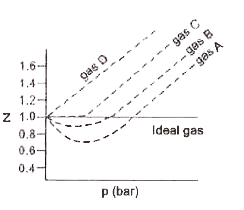Above Boyle point, real gases show (X)_________from ideality and Z values are (Y)______ tha one
X=negative deviation, Y=Less
X=Negative deviation, Y=greater
X=Positive deviation, Y=Less
X=Positive deviation, Y=greater
The correct Answer is:D
(d) Above boyle point, ral gases show positive de3viation from ideality and Z values are greater than one.
Topper's Solved these Questions
Similar Questions
Knowledge Check
- Question 1 - Select One
Real gases show deviation from ideal behaviour at low temperature and high pressure.
Atemperature is low and pressure is highBtemperature si high and Pressure is lowCboth temperature and pressure are lowDboth temperature and pressure are high - Question 2 - Select One
The real gases show deviation from ideal gases donot follow Boyle's law, Charles law and Avogadro law perfectly under all conditions. The deviations from ideal behaviour can be measured in terms of compressibility factor, Z which may be defined as :
Z=pVnRT
It has been observed that Z has values greater than and less than one for different gases. The behaviour of some common gases is shown here.

If Vo is the observed volume of a gas and Vi is the ideal gas volume, then Z isAVo−ViBVo/ViCVi/VoDVi−Vo - Question 3 - Select One
Real gases deviate from an ideal behaviour because gas molecules
Aare spherical in shapeBinteract with each otherCexist freelyDboth 1 and 3
What is an ideal gas? Why do the real gases show deviations from ideal behaviour? Show these deviations graphically.
View SolutionWhy do real gases deviate from Boyle's law?
View SolutionReal gases deviate from ideal behaviour at low temperature and high pressure.
View SolutionThe gases which strictly follow the general equation (PV=nRT) are called ideal or perfect gases. Actually, there is no gas which is perfect or ideal. A real gas is one which actually exists, whether it obeys gas laws strictly or not. Under ordinary conditions, only those gases nearly behave as ideal or perfect which have very low boiling points such as nitrogen, hydrogen ect. The most easily liquefiable and highly soluble gases such as ammonia, carbon dioxide, sulphur dioxide show large deviation
A very convenient method of studying deviation of real gases from ideal behaviour is through a compressibility factor (Z)
Z=PVnRT
(i) Z=1, for ideal gases.
(ii) Z≠1, for real gases.
The units of compressibility factor are :View SolutionThe gases which strictly follow the general equation (PV=nRT) are called ideal or perfect gases. Actually, there is no gas which is perfect or ideal. A real gas is one which actually exists, whether it obeys gas laws strictly or not. Under ordinary conditions, only those gases nearly behave as ideal or perfect which have very low boiling points such as nitrogen, hydrogen ect. The most easily liquefiable and highly soluble gases such as ammonia, carbon dioxide, sulphur dioxide show large deviation
A very convenient method of studying deviation of real gases from ideal behaviour is through a compressibility factor (Z)
Z=PVnRT
(i) Z=1, for ideal gases.
(ii) Z≠1, for real gases.
At Boyle's temperature, compressibility factor Z for a real gas is :View Solution

